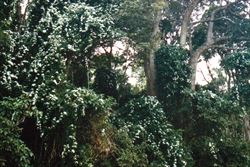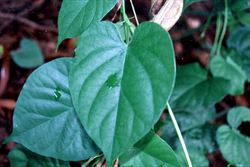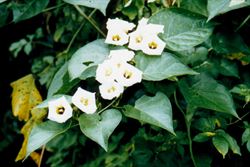Click on images to enlarge

infestation (Photo: Land Protection, QDNRW)

creeping habit (Photo: Land Protection, QDNRW)

older climbing stems (Photo: Land Protection, QDNRW)

leaves (Photo: Land Protection, QDNRW)

close-up of heart-shaped leaf (Photo: Land Protection, QDNRW)

flower clusters (Photo: Land Protection, QDNRW)

tubular white flowers with darker throats (Photo: Land Protection, QDNRW)
Scientific Name
Turbina corymbosa (L.) Raf.
Synonyms
Convolvulus corymbosus L.
Family
Convolvulaceae
Common Names
Christmas pops, Christmas vine, Christmas wreath, Christmasvine, snakeplant, turbina, turbine vine
Origin
Native to Mexico, Central America (i.e. Belize, Costa Rica, Guatemala, Honduras, Nicaragua and Panama), the Caribbean and tropical South America (i.e. Venezuela, Colombia, Ecuador and Peru).
Naturalised Distribution
This species is locally naturalised in the coastal districts of far northern Queensland. It is known from various locations in the drier end of the wet tropics region, and is also present along the Barron River, near Cairns.
It has also become naturalised overseas in south-eastern USA (i.e. Florida), Hawaii, and some other Pacific Islands.
Habitat
Turbine vine (Turbina corymbosa) grows along rainforest margins and waterways (i.e. in riparian vegetation) in wetter tropical regions, where it smothers trees and other vegetation.
In other parts of the world it has been recorded as a weed of roadsides, neglected pastures, vacant lots and gaps in closed forests.
Habit
A scrambling vine or twiner (i.e. liana) that can grow up to 10 m or more in height and can totally blanket vegetation.
Distinguishing Features
- a scrambling vine growing to at least 8 metres in height.
- its alternately arranged leaves are heart-shaped (i.e. cordate).
- it produces many-branched flower clusters in the forks of the current year's leaves.
- its white tubular flowers (2-3 cm long) usually have dark reddish-purple or dark brownish coloured throats.
- its papery capsules (8-15 mm long and 5-6 mm wide) have a pointed tip and five persistent sepals around their base.
Stems and Leaves
The slender younger stems are smooth, green, rounded, and either hairless (i.e. glabrous) or rarely slightly hairy (i.e. puberulent). Two year old stems are thicker, pale grey in colour, and roughly cylindrical, while older stems are woody, deeply fissured and rope-like (up to 13 cm thick).
The alternately arranged leaves are heart-shaped (i.e. cordate) and have pointed tips (i.e. acute apices). These leaves (3-10 cm long and 3-9 cm wide) are bright green on both sides and are borne on stalks (i.e. petioles) 4-6 cm long. There are some short white hairs present along the central vein (i.e. midrib) on the lower side of the leaves, but they are otherwise hairless (i.e. glabrous).
Flowers and Fruit
The many-branched flower clusters are produced in the leaf forks (i.e. axils) of the current year's growth or at the tips of the stems (i.e. in axillary or terminal compound cymes). Each of the tubular flowers (about 2-3 cm long) and has five white petals that are fused together (i.e. into a corolla tube) with five spreading lobes. These fragrant flowers are borne on stalks (i.e. pedicels) 7-12 mm long and have yellowish, dark reddish-purple, or dark brownish coloured throats. They also have five elongated (i.e. lanceolate) sepals (5-12 mm long) with pointed or rounded tips (i.e. acute or obtuse apices), two of which are slightly smaller than the other three. These sepals become enlarged and turn brown as the fruit develop, and they remain on the mature fruit (i.e. they are persistent).
The fruit is a dry and papery capsule (8-15 mm long and 5-6 mm wide) that persists on the thin dead stems. These capsules are oval (i.e. ellipsoid) or somewhat oblong (i.e. ovoid-oblong) in shape and have a short projection (i.e. beak). Each fruit contains one, or occasionally two, dull yellowish-brown or brown seeds. These seeds (8-11 mm long) are egg-shaped (i.e. ovoid) and their surfaces are very finely hairy (i.e. puberulent). Fruit are present mainly during winter (i.e. during May and June).
Reproduction and Dispersal
This species reproduces mainly by seed.
The mature dried fruit float readily on water and they may also be spread by the wind (i.e. the enlarged sepals act like propeller blades and allow the fruit to spin and glide some distance). Seeds may also be dispersed by birds.
Environmental Impact
Turbine vine (Turbina corymbosa) is rgarded as an environmental weed in northern Queensland, and is thought to be among the most significant rainforest weeds in the wet tropics region of this state.
Legislation
Not declared or considered noxious by any state government authorities.
Similar Species
Turbine vine (Turbina corymbosa) is very similar to obscure morning glory (Ipomoea obscura) and relatively similar to moonflower (Ipomoea alba). All three of these species have whitish tubular flowers and heart-shaped (i.e. cordate) leaves. However, they can be distinguished by the following differences:
- turbine vine (Turbina corymbosa) has relatively small tubular flowers (2-3 cm long) with reddish-purple or brownish coloured throats. These flowers are borne in large, many-branched, clusters in the leaf forks or at the tips of the stems. Its fruiting capsules are slightly elongated in shape (8-15 mm long and 5-6 mm wide) and contain one or two yellowish-brown or brown seeds (8-11 mm long).
- obscure morning glory (Ipomoea obscura) has relatively small tubular flowers (1.4-2.5 cm long) with reddish-purple or brownish coloured throats. These flowers are borne singly or in small clusters in the leaf forks. Its fruiting capsules are rounded in shape (8-12 mm long and 8-12 mm wide) and contain one to four black seeds (5-6 mm long).
- moonflower (Ipomoea alba) has relatively large tubular flowers (7-15 cm long) with very narrow greenish-white coloured throats. These flowers are borne singly or in small clusters in the leaf forks. Its fruiting capsules are rounded or slightly elongated in shape (20-30 mm long) and contain four white, brown or black seeds (7-10 mm long).

